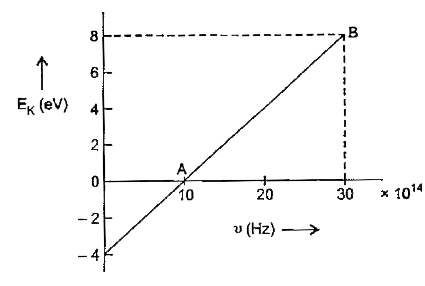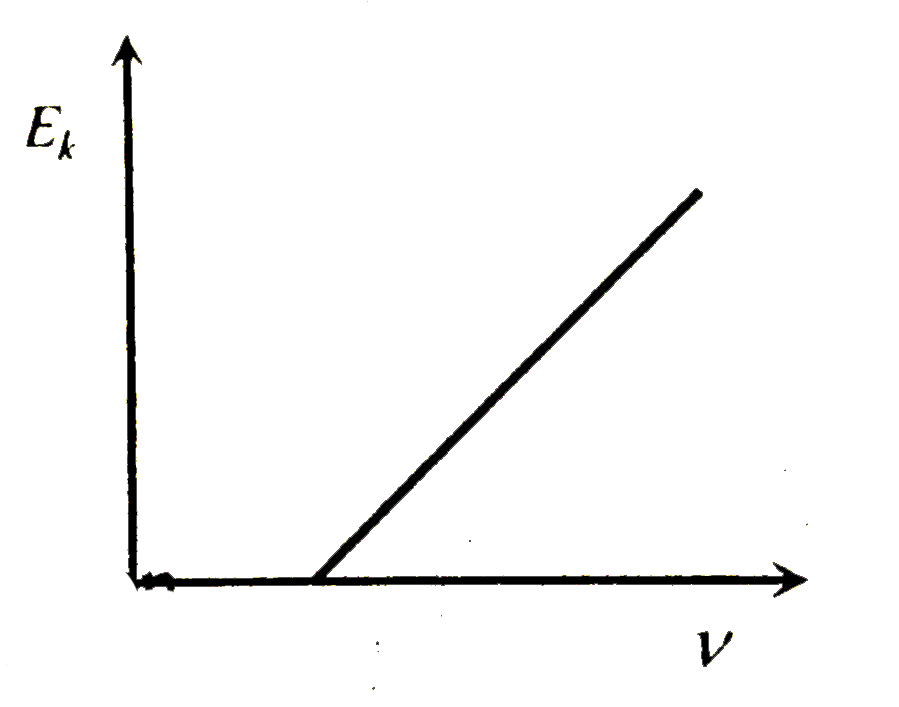In an experiment of photoelectric effect, the graph of maximum kinetic energy EK of the emitted photoelectrons versus the frequency v of the incident light is a straight line AB as shown in Figure below:
Find : (i) Threshold frequency of the metal.
(ii) work function of the metal
(iii) Stopping potential for the photoelectrons emitted by the light of frequency v=30×1014 Hz.
To solve the question regarding the photoelectric effect, we will follow these steps:
Step 1: Determine the Threshold Frequency
The threshold frequency (v0) is the frequency at which the maximum kinetic energy (EK) of the emitted photoelectrons becomes zero. From the graph, this corresponds to the x-intercept of the line AB.
From the graph:
- The x-intercept occurs at v=10×1014 Hz.
Answer:
(i) The threshold frequency of the metal is v0=10×1014 Hz.
Step 2: Calculate the Work Function
The work function (W) of the metal can be calculated using the formula:
W=h⋅v0
where h is Planck's constant (6.626×10−34 J s).
Calculation:
- Convert the threshold frequency to Joules:
W=(6.626×10−34 J s)⋅(10×1014 Hz)=6.626×10−20 J
- Convert Joules to electronvolts (1 eV = 1.6×10−19 J):
W=6.626×10−20 J1.6×10−19 J/eV≈0.414 eV
Answer:
(ii) The work function of the metal is W≈0.414 eV.
Step 3: Calculate the Stopping Potential
The stopping potential (Vs) can be calculated using the formula:
eVs=EK
where EK is the maximum kinetic energy of the emitted photoelectrons when the frequency v=30×1014 Hz.
Calculation of Maximum Kinetic Energy:
Using the equation for kinetic energy:
EK=h(v−v0)
Substituting the values:
EK=h(30×1014−10×1014)=h(20×1014)
EK=(6.626×10−34)⋅(20×1014)=1.3252×10−19 J
Convert to eV:
EK=1.3252×10−191.6×10−19≈0.828 eV
Stopping Potential Calculation:
The stopping potential is given by:
Vs=EKe
Thus:
Vs≈0.828 volts
Answer:
(iii) The stopping potential for the photoelectrons emitted by the light of frequency v=30×1014 Hz is approximately Vs≈0.828 volts.
Summary of Answers:
(i) Threshold frequency v0=10×1014 Hz
(ii) Work function W≈0.414 eV
(iii) Stopping potential Vs≈0.828 volts
The threshold frequency (v0) is the frequency at which the maximum kinetic energy (EK) of the emitted photoelectrons becomes zero. From the graph, this corresponds to the x-intercept of the line AB.
- The x-intercept occurs at v=10×1014 Hz.
(i) The threshold frequency of the metal is v0=10×1014 Hz.
The work function (W) of the metal can be calculated using the formula:
W=h⋅v0
where h is Planck's constant (6.626×10−34 J s).
- Convert the threshold frequency to Joules:
W=(6.626×10−34 J s)⋅(10×1014 Hz)=6.626×10−20 J
- Convert Joules to electronvolts (1 eV = 1.6×10−19 J):
W=6.626×10−20 J1.6×10−19 J/eV≈0.414 eV
(ii) The work function of the metal is W≈0.414 eV.
The stopping potential (Vs) can be calculated using the formula:
eVs=EK
where EK is the maximum kinetic energy of the emitted photoelectrons when the frequency v=30×1014 Hz.
Using the equation for kinetic energy:
EK=h(v−v0)
Substituting the values:
EK=h(30×1014−10×1014)=h(20×1014)
EK=(6.626×10−34)⋅(20×1014)=1.3252×10−19 J
Convert to eV:
EK=1.3252×10−191.6×10−19≈0.828 eV
The stopping potential is given by:
Vs=EKe
Thus:
Vs≈0.828 volts
(iii) The stopping potential for the photoelectrons emitted by the light of frequency v=30×1014 Hz is approximately Vs≈0.828 volts.
(i) Threshold frequency v0=10×1014 Hz
(ii) Work function W≈0.414 eV
(iii) Stopping potential Vs≈0.828 volts
Similar Questions
In an experiment of photo-electric effect, the graph of maximum kinetic energy Ek of the emitted photoelectrons versus the frequency v of the incident light is a straight line AB as shown in figure below :

Threshold frequency of the metal.
View SolutionIn an experiment of photo-electric effect, the graph of maximum kinetic energy Ek of the emitted photoelectrons versus the frequency v of the incident light is a straight line AB as shown in figure below :

Work function of the metal.
View Solution
Knowledge Check
According to Einstein's photoelectric equation, the plot of the maximum kinetic energy of the emitted photoelectrons from a metal versus frequency of the incident radiation gives a straight line whose slope
Adepends on the intensity of incident radiation.Bdepends on the nature of the metal and also on the intensity of incident radiation.Cis same for all metals and independent of the intensity of the incident radiation.Ddepends on the nature of the metal.
In an experiment of photo-electric effect, the graph of maximum kinetic energy Ek of the emitted photoelectrons versus the frequency v of the incident light is a straight line AB as shown in figure below :

Stopping potential for the photoelectrons emitted by the light of frequency
v=30×1014Hz
View SolutionMaximum kinetic energy (Ek) of a photoelectron varies with the frequency (v) of the incident radiation as
View SolutionFor the photoelectric effect, the maximum kinetic energy Ek of the emitted photoelectrons is plotted against the frequency of the incident photons as shown in the figure. The slope of the curve gives

View SolutionThe stopping potential in an experiment on photoelectric effect is 2V. What is the maximum kinetic energy of the photoelectrons emitted ?
View SolutionThe correct graph respectivley the relation between energy (E) of photoelectrons and frequency v of incident light is
View Solution
The maximum kinetic energy of the emitted photoelectrons against frequency υ of incident radiation is plotted as shown in Fig. This graph help us in determining the following physical quantities
View SolutionA graph regarding photoelectric effect is shown between the maximum kinetic energy of electrons and the frequency of the incident light. On the basis of data as shown in the graph, calculate (a) threshold frequency , (b) work- function, (c ) planck constant

View Solution
